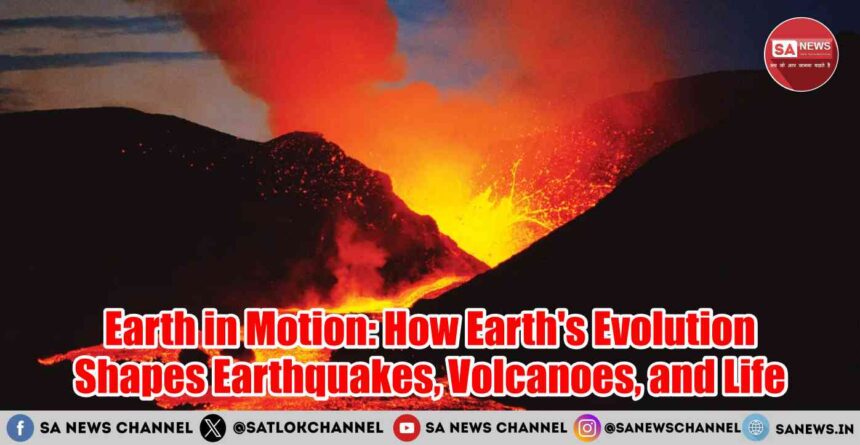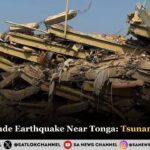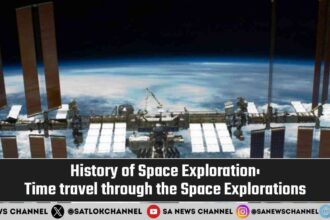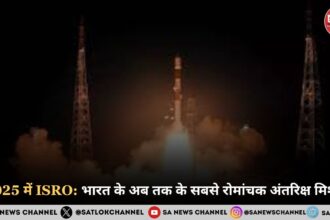In recent months, strong earthquakes and volcanic eruptions have shaken many regions, serving as a reminder of Earth’s ongoing geological activity. Myanmar and Thailand recently experienced significant earthquakes, while Tonga was also affected by seismic disturbances.
- The Origin and Evolution of Earth
- Formation of the Earth
- Key Stages of Earth’s Evolution
- Hadean Eon (4.6–4.0 billion years ago)
- Archean Eon (4.0–2.5 billion years ago)
- Proterozoic Eon (2.5 billion–541 million years ago)
- Phanerozoic Eon (541 million years ago–present)
- Major Events That Changed Earth
- The Interior of the Earth
- Wegener’s Continental Drift Theory
- Plate Tectonics: The Engine of Earth’s Movement
- Earthquakes: The Tremors of Earth
- Volcanoes: Earth’s Vents
- The Connection Between Earth’s Processes
- Conclusion
- Teachings of Sant Rampal Ji Maharaj on the Temporary Nature of the Material World
Meanwhile, Hawaii’s Kilauea Volcano, Japan’s Shinmoedake Volcano, and Alaska’s Mount Spurr are either actively erupting or being closely observed for potential activity. These events highlight the dynamic nature of our planet and the powerful forces operating beneath its surface.
Earth is constantly evolving due to deep geological forces that have been shaping its surface for billions of years. To comprehend these processes, we need to explore the formation of Earth, its internal structure, and the mechanisms driving geological changes. By understanding plate tectonics, earthquakes, and volcanoes, we can better appreciate how these forces have molded our world and how they continue to impact life on Earth.
The Origin and Evolution of Earth
Formation of the Earth
About 4.6 billion years ago, Earth emerged from a vast swirling cloud of gas and cosmic dust known as the solar nebula. The process of accretion, driven by gravity, caused dust particles and rock fragments to clump together, gradually forming larger celestial bodies. Over time, one of these bodies grew massive enough to become our planet. Initially, Earth was a chaotic, molten sphere bombarded by asteroids and comets, with extreme temperatures preventing the formation of solid land or stable water bodies.
As time passed, the planet cooled. Heavier elements such as iron and nickel sank toward the center, creating the core, while lighter materials formed the mantle and the crust. This layering process laid the foundation for the geological activity that continues to shape Earth today.
Key Stages of Earth’s Evolution
Hadean Eon (4.6–4.0 billion years ago)
- Earth’s surface was covered in molten rock, making it unfit for life.
- Constant asteroid impacts caused extreme heat.
- Water began collecting as steam from volcanic eruptions cooled and condensed.
- A dense atmosphere formed, consisting mainly of carbon dioxide, methane, and ammonia.
- The first signs of planetary differentiation began, setting the stage for future geological processes.
Archean Eon (4.0–2.5 billion years ago)
- The first continents and oceans started forming.
- Microbial life appeared in oceans, starting the chain of biological evolution.
- The planet’s surface stabilized, with early plate movements shaping geography.
- Stromatolites, formed by microbial life, started releasing oxygen into the atmosphere.
Proterozoic Eon (2.5 billion–541 million years ago)
- Oxygen levels increased due to photosynthetic microorganisms, leading to the Great Oxidation Event.
- Multicellular life forms evolved into more complex organisms.
- The first large-scale glaciations, called Snowball Earth events, took place.
- Rodinia, one of the first supercontinents, formed and later broke apart.
Phanerozoic Eon (541 million years ago–present)
- A major expansion of complex life led to plants, animals, and diverse ecosystems.
- Continents merged and split multiple times, forming supercontinents like Pangaea.
- Climate changes, mass extinctions, and evolutionary advances shaped modern biodiversity.
- Humans emerged in the last 2 million years, altering Earth’s ecosystems dramatically.
Major Events That Changed Earth
- The Great Oxidation Event – Oxygen transformed Earth’s atmosphere, allowing more complex life to thrive.
- The Cambrian Explosion – A rapid increase in biodiversity led to the development of most modern animal groups.
- Supercontinent Cycles – Continents continually merge and separate, affecting climate and ocean currents.
The Interior of the Earth
Layers of the Earth
Earth’s interior consists of three main layers:
- Core – Made primarily of iron and nickel, with a solid inner core and a liquid outer core responsible for generating Earth’s magnetic field.
- Mantle – A thick, slowly moving layer of semi-solid rock that drives tectonic activity.
- Crust – The thin, outermost layer where continents and oceans exist.
How Earth’s Interior Influences the Surface
The heat and movement within Earth cause volcanoes to erupt, earthquakes to occur, and mountains to form, continually reshaping the planet’s surface.
Wegener’s Continental Drift Theory
What is the Theory?
In 1912, Alfred Wegener proposed that continents were once joined in a single landmass called Pangaea, which later drifted apart. This idea was initially dismissed but later became the foundation of plate tectonics.
Evidence for Continental Drift
- Matching Coastlines – Continents like South America and Africa fit together like puzzle pieces.
- Fossil Evidence – Identical fossils have been found on distant continents.
- Geological Similarities – Similar rock formations exist on continents now separated by oceans.
- Climate Clues – Fossils of tropical plants have been discovered in Antarctica, showing that continents have shifted over time.
Plate Tectonics: The Engine of Earth’s Movement
How Plates Move
Heat from Earth’s core creates convection currents in the mantle, causing plates to shift. This movement drives earthquakes, volcanic eruptions, and mountain formation.
Types of Plate Boundaries
- Divergent Boundaries – Plates move apart, creating new crust (e.g., Mid-Atlantic Ridge).
- Convergent Boundaries – Plates collide, forming mountains or deep trenches (e.g., Himalayas, Mariana Trench).
- Transform Boundaries – Tectonic plates move against one another, leading to earthquakes, such as those along the San Andreas Fault.
Earthquakes: The Tremors of Earth
What Causes Earthquakes?
Stress builds along fault lines, and when released, it sends seismic waves through the ground.
Measuring Earthquakes
- Richter Scale – Measures magnitude according to the amplitude of the wave.
- Moment Magnitude Scale (Mw) – More accurately measures energy release.
Earthquake Safety
Building earthquake-resistant structures, having emergency plans, and using early warning systems can help reduce risks.
Volcanoes: Earth’s Vents
How Volcanoes Form
Magma rises through the crust, erupting as lava, ash, and gases.
Types of Volcanoes
- Shield Volcanoes – Broad, with gentle slopes (e.g., Mauna Loa).
- Stratovolcanoes – Steep, explosive volcanoes (e.g., Mount St. Helens).
- Cinder Cone Volcanoes – Small, steep-sided cones of volcanic debris.
The Connection Between Earth’s Processes
The Earth’s interior, plate tectonics, earthquakes, and volcanoes work together to shape our planet. These processes constantly reshape landscapes, impact ecosystems, and affect human civilization.
Conclusion
From its fiery beginnings to its ever-changing surface, Earth remains in motion. Understanding plate tectonics, earthquakes, and volcanoes helps us prepare for natural disasters and appreciate the forces that shape our world. By studying these processes, we can protect our planet and ensure a sustainable future for generations to come.
Teachings of Sant Rampal Ji Maharaj on the Temporary Nature of the Material World
Earth is always changing, from its fiery origins to the ongoing geological activities we see today. This teaches us about the temporary nature of the physical world. Events like earthquakes and volcanic eruptions reveal Earth’s active character and the unpredictability of life. The teachings of Saint Rampal Ji Maharaj offer a deep spiritual insight into these situations. He points out that the physical world, with its cycles of creation and destruction, is not permanent. To find true peace and stability, one should seek the eternal Supreme God, Kabir Sahib.
Sant Rampal Ji Maharaj notes that natural upheavals serve as reminders to look for stability beyond the physical world. By following the divine knowledge and devotion imparted by a Tatvadarshi Saint, individuals can face life’s challenges with spiritual understanding. Just as Earth’s processes reshape the planet, spiritual wisdom can transform the soul, preparing it for liberation from the cycles of life and death.
By embracing the timeless teachings of Kabir Sahib and following the guidance of Sant Rampal Ji Maharaj, people can achieve inner peace and security, even in the face of nature’s unpredictability. This journey leads to a life in harmony with the divine—something that transcends the impact of material disasters.









